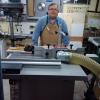Bill, there are benefits on a saw and jointer, the braking is nice on both if you use a VFD (like Matt said). Another benefit of VFD three phase on a saw is the ability to change blade speed when changing sizes. VFD can also move between machines, I have one with a wired plug in and out that allows simple moving. Works for the drill press and the lathe.
As for three phase power into your building, that is a great benefit. As others have said, it opens up a whole new level of machinery availability without having to have the extra costs of VFD or converters. I have a welding/fab shop, three phase welders usually have much better duty cycles. Right now, there is a really expensive Miller 400 amp machine with 100% duty cycle available locally, for ridiculously cheap. The little plant it's in is just buying new machines, nothing wrong with it. Great to have access to that sort of thing if you need it.






 Reply With Quote
Reply With Quote


